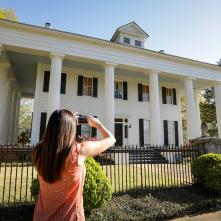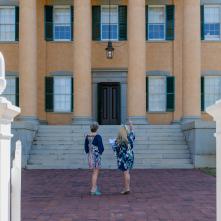Daydreaming about traveling? We are missing all our visitors. Today let us take you on a virtual tour of three of Milledgeville's charming historic sites: Georgia's Old Governor's Mansion, Andalusia Farm and the John Marlor Arts Center. Sit back and relax as you experience a bit of Milledgeville.
Georgia'sOld Governor's Mansion
Georgia's Old Governor's Mansion
Completed in 1839, Georgia's Old Governor's Mansion is one of the finest examples of High Greek Revival architecture in the nation. Designed by noted architect Charles Cluskey, an Irish immigrant and built by Timothy Porter of Farmington, Connecticut, the Mansion looms over Milledgeville with its stately columns and imposing facade. Serving as the residence for Georgia's chief executives for over thirty years, the Mansion's history encompasses the antebellum, Civil War, and early Reconstruction phases of the state's history. Such noted state leaders as George Crawford, Howell Cobb and Joseph E. Brown resided in the building and used it as a stage for speeches and also to introduce guests of national standing.
Georgia's Old Governor’s Mansion also served as a stage on which many elements of the complex social issues of the antebellum period were played out. Slavery and the complexity of society and gender roles are among the issues that shape the history of the building and are explored in tandem with the issues of politics. During the Civil War, the Mansion was claimed as a "prize" in the "March to the Sea," when General William T. Sherman headquartered in the building on November 23, 1864. Following the war, Georgia's seat of government was relocated to Atlanta, and the Mansion was abandoned. Given over to Georgia Normal & Industrial College (currently known as Georgia College) in 1889, the Mansion served as the founding building of the institution and is the campus's most treasured structure.
Andalusia Farm
Andalusia Farm: Home of Flannery O'Connor
Andalusia Farm served as the home of famed American author Flannery O’Connor from 1951-1964. First settled in 1814, Andalusia was a cotton plantation and farm until it was purchased by Flannery’s uncle Dr. Bernard Cline in 1931. During the O’Connor’s residency, the site contained 14 buildings with over 520 acres of land that was used for dairy and beef farming. After becoming very sick on her way to see her family for Christmas in 1950, Flannery was diagnosed with Lupus, the same disease that killed her father. O’Connor moved to Andalusia to live under the care of her mother Regina Cline O’Connor.
During the 13 years she lived at Andalusia, she completed the bulk of her literary work, as the farm’s environment influenced the setting of many of her writings. The parlor and bedroom on the end of the house were an addition made by Flannery’s uncle Louis Cline in the late 1950s. Flannery especially loved the large bookcases in this room which she brought to Andalusia from her cousin’s house in Savannah. Flannery purchased the refrigerator after selling the film rights to one of her short stories, “The Life You Save May Be Your Own.” Flannery kept many peafowl as pets while she lived here. Her flock eventually grew to around 50 of them. Following her death in 1964, the farm remained in the family until 2003 when it was given to a private foundation for use as a museum. In August 2017, the site was gifted to O’Connor’s alma mater, Georgia College.
John Marlor Arts Center
John Marlor Arts Center
If you’ve walked the streets of Milledgeville, chances are you’ve noticed some of the gorgeous homes and buildings we have. But, did you know that we have an entire style of architecture named after our city? That’s right. We’re famous in the architecture world and it’s all thanks to one man: John Marlor.
Marlor was born in England in 1789, but little is known about his early life. What we do know is that he moved from England to Charleston, South Carolina soon after he was born. It was from Charleston that he made his way to Milledgeville and our town would soon be changed forever. In 1820, Marlor landed in Milledgeville and began his 20 year career that would alter the landscape of our town. Mostly self-taught, Marlor had an interesting take on different architectural styles. His personal style relied on a combination of Georgian and Federal structures with more complex elements being added in as he began to gain experience. In the end, he created an entirely new style known as “Milledgeville Federal”, characterized by side-gabled roofs, spiral staircases, and fanlight front entrances. Marlor died in 1835 in Milledgeville and is buried in Memory Hill Cemetery.
This house was built by Marlor as a present to his second wife in 1830. The home contains all of the iconic aspects of John Marlor’s signature style, including a portico with Doric columns, a cantilevered balcony, and a circular staircase. This building, the John Marlor Arts Center, is one of three historic buildings that make up the Allied Arts Center. The building is located on 201 North Wayne Street and located within an area was once known as "The Strip" which was the heart of the African-American district until the 1980's. It now houses arts offices and the Marlor Art Gallery. Allied Arts offers arts camps and workshops for all ages and hosts a gallery of visiting artists that changes bimonthly.
 Things To Do
Things To Do
 Events
Events
 Food & Drink
Food & Drink
 Hotels & Lodging
Hotels & Lodging
 Plan Your Trip
Plan Your Trip

